You’ll discover that Indiana’s native plants aren’t just survivors, they’re champions of adaptation. These hardy species have weathered centuries of Midwest extremes, from bone-chilling winters to sweltering summers, developing remarkable resilience that makes your gardening efforts practically foolproof. Unlike finicky non-natives that demand constant attention, Indiana’s indigenous plants thrive with minimal intervention, requiring less water, fertilizer, and pest control. But choosing the right species for your specific location requires understanding something most gardeners overlook.
Contents
- 1 Indiana’s Diverse Climate Zones
- 2 Indigenous Wildflowers for Indiana
- 3 Indiana’s Best Native Trees
- 4 Indiana’s Hardy Native Shrubs
- 5 Selecting the Right Native Plants for Your Garden
- 6 Frequently Asked Questions
- 6.1 When Is the Best Time to Plant Native Species in Indiana?
- 6.2 How Much Do Native Plants Typically Cost Compared to Non-Native Varieties?
- 6.3 Where Can I Purchase Native Indiana Plants and Seeds Locally?
- 6.4 Do Native Plants Require Special Fertilizers or Soil Amendments?
- 6.5 How Long Do Native Plants Take to Establish After Planting?
Indiana’s Diverse Climate Zones
When you’re selecting plants for your Indiana garden, understanding the state’s climate zones becomes your roadmap to success. Indiana spans USDA hardiness zones 5b through 7a, with winter temperatures ranging from -15°F in the north to above 0°F in southern regions. Northern Indiana sits in Zone 5b, central areas fall within Zone 6a, and southern portions enjoy Zone 6b conditions. This relatively narrow range makes zone specific gardening manageable for most Hoosier gardeners. The updated Plant Hardiness Zone Map released in December 2023 provides the most accurate guidance yet, incorporating advanced mapping techniques and weather data from 1991 to 2020. Developing effective climate adaptation strategies means recognizing that your location determines which native plants will thrive through Indiana’s variable winter conditions.
Indigenous Wildflowers for Indiana
Indiana’s indigenous wildflowers offer year-round beauty through spring blooms, summer gardens, fall colors, textural grasses, and specialized plants adapted to specific growing conditions. These native perennials serve as superb pollinator plants, attracting bees, butterflies, and hummingbirds throughout the growing season.
Purple Coneflower (Echinacea Purpurea)
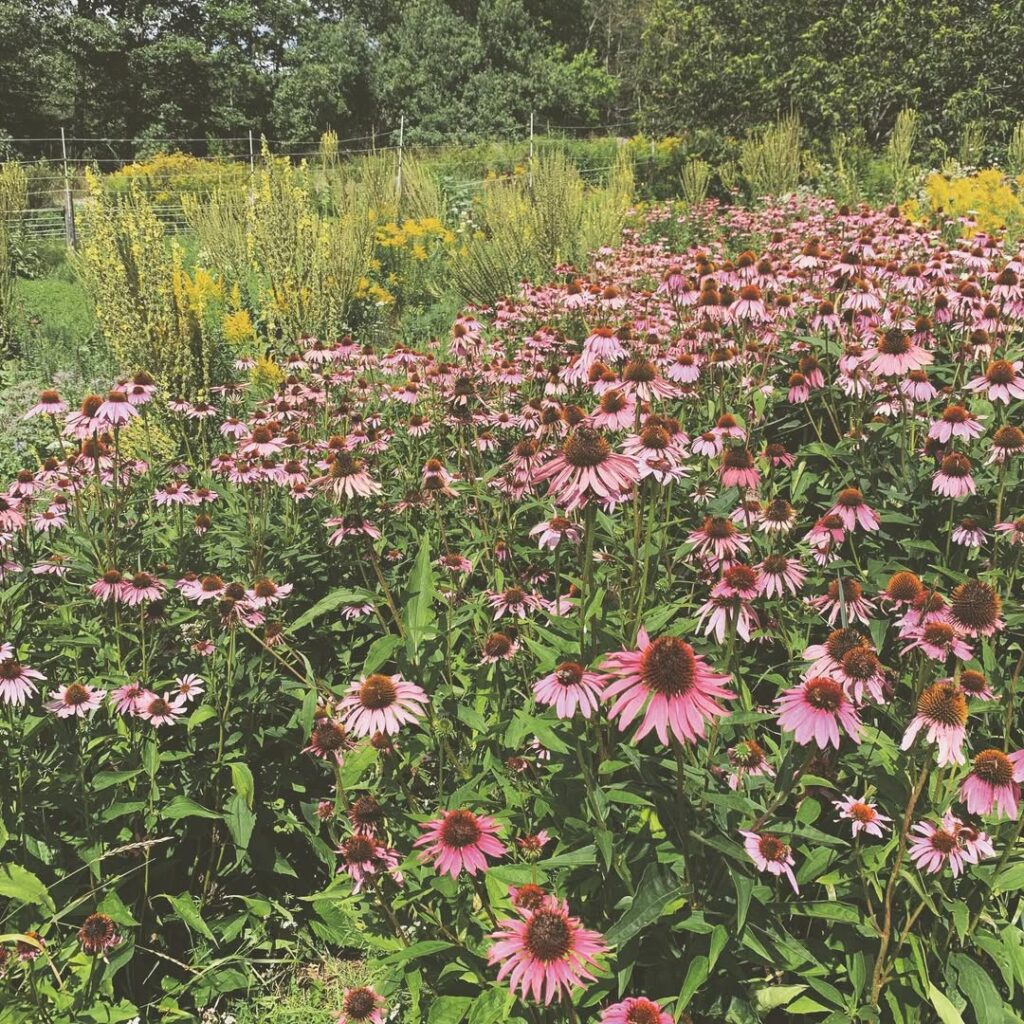
Purple Coneflower (Echinacea purpurea) is a beloved native Indiana wildflower that reaches 2-4 feet tall with distinctive lavender-purple daisy-like blooms featuring drooping petals and spiny brownish centers. This herbaceous perennial thrives in prairies, open woodlands, and garden settings throughout the state.
Its long-lasting summer flowers attract butterflies, native bees, and other pollinators, making it essential for supporting local ecosystems. The plant’s sturdy, unbranched stems and rough-textured leaves create attractive garden displays while requiring minimal maintenance. With a C-value of 6, Purple Coneflower indicates moderate habitat quality and serves as an excellent choice for native plant landscaping and prairie restoration projects. Beyond its ornamental value, the plant produces cypsela fruits that provide additional wildlife benefits as the growing season progresses.
- Hardiness: Zones 3-8, extremely hardy native perennial
- Light: Full sun to partial shade, adaptable to various light conditions
- Water: Moderate moisture needs, drought-tolerant once established
- Soil: Well-drained mesic soils preferred, tolerates various soil types
- Fertilizer: Minimal to no fertilization needed, thrives in native conditions
- Pest/Disease Resistance: Generally resistant with few serious pest or disease issues
- Growth Rate: Moderate growth rate with reliable year-to-year establishment
Wild Bergamot (Monarda Fistulosa)

Wild Bergamot (Monarda fistulosa) is a highly aromatic herbaceous perennial native to Indiana, featuring square, hairy stems and clusters of pink to lavender flowers. Growing 3-5 feet tall with a similar spread, this hardy wildflower produces profuse summer blooms from June to August that attract bees, butterflies, and hummingbirds. The edible flowers and leaves have been historically used for tea and medicinal purposes.
This low-maintenance native plant thrives in various soil conditions and requires minimal care once established, making it ideal for beginner gardeners. Wild Bergamot serves as an excellent pollinator plant while providing natural deer resistance and erosion control. As a member of the mint family, it shares characteristics with other Lamiaceae species and contributes to garden biodiversity. It pairs well with other native species like rudbeckia and verbena in naturalized garden settings.
- Hardiness: Perennial, well-adapted to Indiana climate zones
- Light: Full sun preferred; tolerates partial shade
- Water: Dry to medium moisture when established; needs more water first year
- Soil: Well-drained loam, sand, rocky, or clay; pH 6.0-7.5
- Fertilizer: Not required; thrives in various soil fertility levels
- Pest/Disease Resistance: Deer resistant; susceptible to powdery mildew in poor airflow
- Growth Rate: Moderate; easily propagated by seed or division
Wild Lupine (Lupinus Perennis)

Wild Lupine (Lupinus perennis) is a herbaceous perennial native to eastern and midwestern North America, particularly thriving in northern Indiana’s sandy dunes and savannas. This distinctive plant features palmately compound leaves with 7-12 leaflets and produces striking spikes of blue-purple, pea-like flowers in late spring to early summer, typically reaching 1-2 feet in height. As a member of the Fabaceae family, Wild Lupine shares characteristics with over 13,000 species worldwide including garden peas, beans, and clovers.
As a keystone species, Wild Lupine serves critical ecological functions, most importantly as the sole larval food source for the federally endangered Karner blue butterfly. The plant also supports various moths, skippers, and other butterfly larvae while providing pollen rewards for bee and fly pollinators. Unfortunately, natural populations have declined considerably due to habitat loss from fire suppression, agriculture, and development, making conservation efforts increasingly important for maintaining native sand prairie ecosystems.
- Hardiness: Zones 3-8, adapted to Midwest conditions
- Light: Full sun to light shade
- Water: Low to moderate; drought tolerant once established
- Soil: Well-drained, sandy, acidic soils; poor performance in heavy clay
- Fertilizer: None required; adapted to nutrient-poor soils
- Pest/Disease Resistance: Generally resistant with few issues
- Growth Rate: Fast to flower from seed; short-lived perennial that self-seeds readily
New England Aster (Symphyotrichum Novae-Angliae)
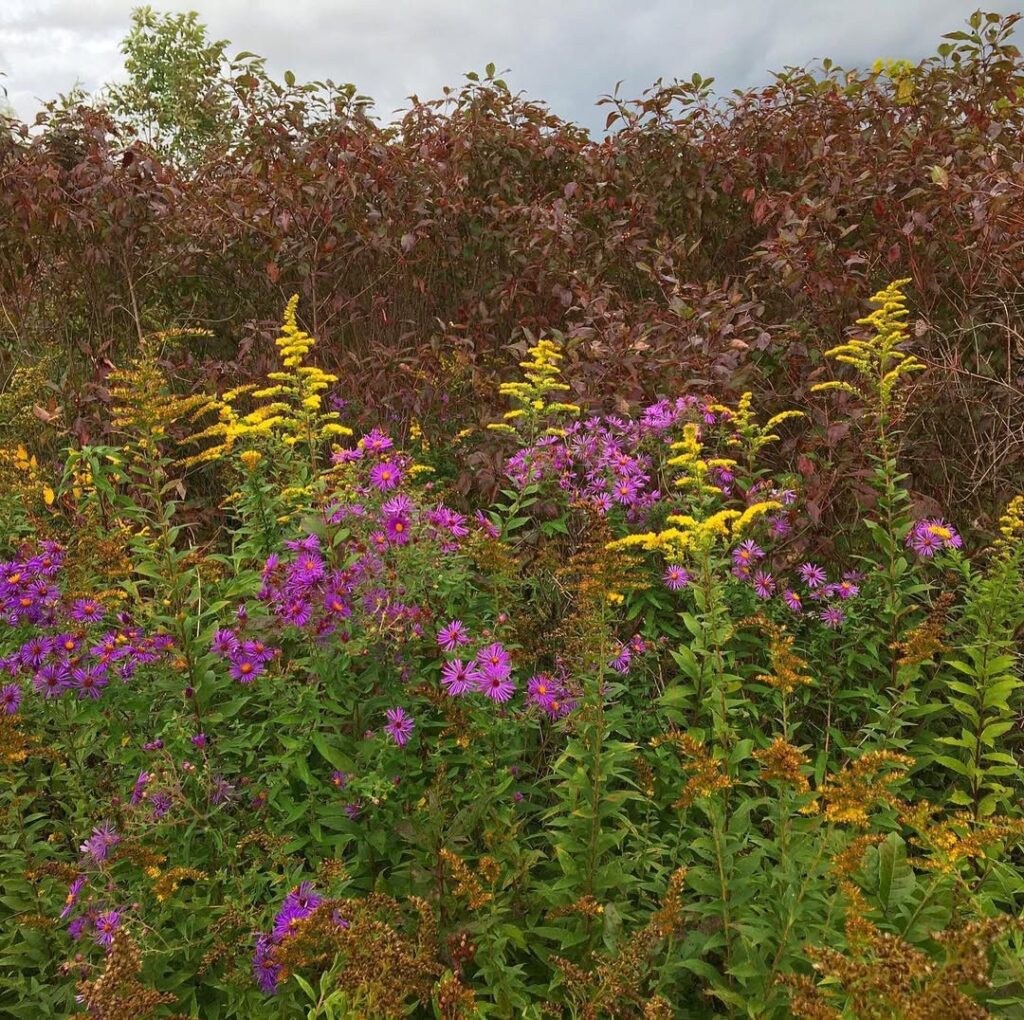
New England Aster (Symphyotrichum novae-angliae) is a native perennial wildflower that serves as a cornerstone species for Indiana’s late-season pollinator support. This hardy plant produces vibrant purple flowers with yellow centers from August through October, making it invaluable for migrating monarch butterflies and native bumble bees preparing for winter.
Beyond its ecological importance, New England Aster offers exceptional versatility in landscape applications. It thrives in various conditions from sun to partial shade and adapts to different soil types while maintaining drought tolerance. The plant works beautifully in cottage gardens, pollinator gardens, and naturalization projects, with the compact ‘Purple Dome’ cultivar providing an excellent option for smaller spaces. This impressive wildflower can reach 6 or more feet in height with densely arranged hairy leaves on stout stems, creating a dramatic vertical presence in late-season gardens.
- Hardiness: Perennial, frost-tolerant, blooms until first hard frost
- Light: Sun to part shade, adapts to various light conditions
- Water: Medium-wet to medium-dry, drought-tolerant but prefers consistent moisture
- Soil: Moist, acidic soils (pH<6.8) preferred; tolerates average, loam, and clay soils
- Fertilizer: Low maintenance, no supplemental fertilization typically needed
- Pest/Disease Resistance: Deer and rabbit resistant, generally pest-free
- Growth Rate: Moderate to fast, can become aggressive if not maintained, divide every few years
Black-Eyed Susan (Rudbeckia Hirta)
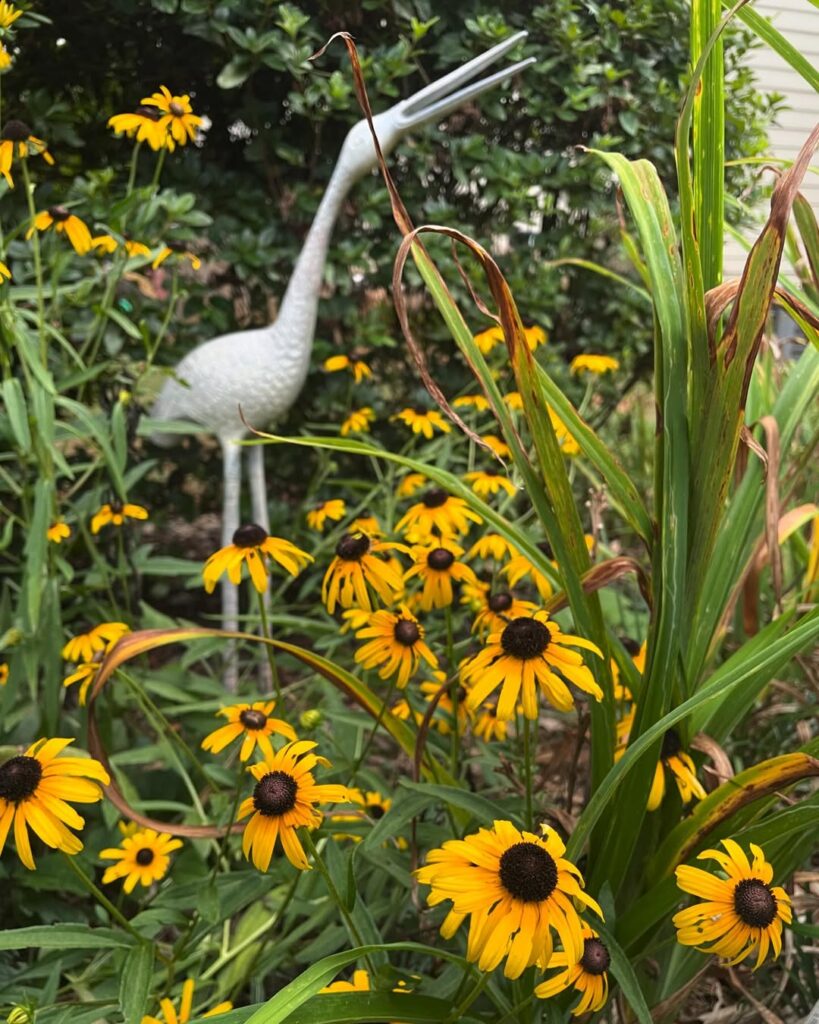
Black-Eyed Susan (Rudbeckia hirta) is a versatile native wildflower that brings vibrant golden-yellow, daisy-like blooms to Indiana landscapes from summer through fall. This hardy pioneer species grows 1-3 feet tall with distinctive dome-shaped centers surrounded by bright ray petals. As a warm-season plant, it can function as an annual, biennial, or short-lived perennial, producing more abundant flowers in its second year.
This adaptable wildflower thrives in open, sunny locations and serves as an important component of prairie ecosystems. Black-Eyed Susan provides vital nectar resources for native bees and other beneficial insects while rapidly colonizing disturbed areas. Its ability to self-seed and regenerate from root crowns makes it valuable for naturalized plantings and wildflower meadows throughout the region. The plant serves as a host plant for at least 15 lepidopteran species, supporting local butterfly and moth populations.
- Hardiness: Zones 3-9; native warm-season plant adaptable as annual, biennial, or short-lived perennial
- Light: Full sun; thrives in open, sunny areas
- Water: Low to moderate; drought tolerant once established, prefers dry to average moisture
- Soil: Well-drained soils; adaptable to various soil conditions including poor soils
- Fertilizer: Low maintenance; typically requires no supplemental fertilization
- Pest/Disease Resistance: Generally pest and disease resistant; hardy pioneer species
- Growth Rate: Fast; rapid establishment and colonization, blooms first year from seed
Indiana’s Best Native Trees
Indiana’s diverse climate supports numerous hardy native tree species, from towering shade trees and productive fruit varieties to stunning flowering specimens and resilient conifers adapted to local conditions. These native species include distinctive varieties like the Tulip Tree with its unique tulip-shaped leaves and colorful spring flowers that make it easily recognizable in Indiana woodlots.
American Basswood (Tilia Americana)

The American Basswood is a majestic native Indiana tree that grows 50-150 feet tall with a distinctive heart-shaped leaf and smooth bark marked by long vertical lines. Known as the “Bee-tree” for its highly attractive flowers that produce strongly flavored honey, this adaptable species evolves from a conical shape in youth to a broad, rounded crown with maturity.
This rapid-growing tree serves dual purposes as both an important timber species and popular urban shade tree. Its soft, light wood has been utilized for centuries in furniture making and food boxes, while Native Americans traditionally crafted ropes from its fibrous inner bark. The basswood provides excellent wildlife habitat, offering nesting cavities in hollow trunks and food sources through its seeds and twigs. The fragrant flowers bloom from April to July, creating an extended period of nectar availability for pollinators.
- Hardiness: Native to Indiana, thrives from southern Canada through northern Arkansas and Great Lakes region
- Light: Adaptable to various light conditions
- Water: Prefers moist conditions but widely adaptable
- Soil: Best growth on deep, moist, loamy soils but tolerates various soil types
- Fertilizer: Low maintenance, typically doesn’t require supplemental fertilization
- Pest/Disease Resistance: Generally hardy with good natural resistance
- Growth Rate: Rapid-growing with vigorous development from both seeds and sprouts
Eastern Redbud (Cercis Canadensis)
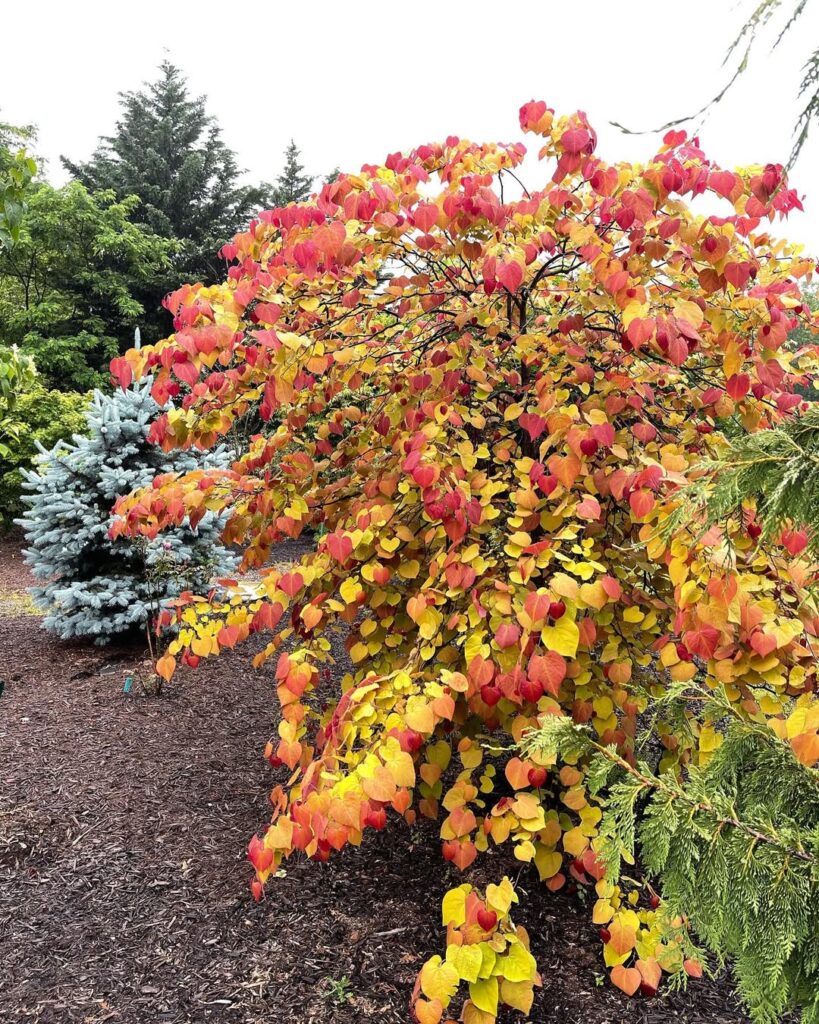
The Eastern Redbud is a stunning native deciduous tree that grows 15-30 feet tall with a distinctive maroon-purple trunk and heart-shaped leaves. This small tree creates spectacular early spring displays with clusters of pink flowers that appear before the leaves emerge, creating a striking haze of color in Indiana’s bare woodlands.
Valued primarily as an ornamental tree, the Eastern Redbud features distinctive zig-zag twigs, reddish-brown flaky bark, and flat seed pods that persist through winter. Its umbrella-like crown and ability to grow with single or multiple trunks make it an excellent choice for yards, parks, and street plantings throughout Indiana. The tree offers special value to native bees and bumblebees by providing essential nesting materials.
- Hardiness: USDA zones 4-9, native throughout eastern United States including Indiana
- Light: Full sun to partial shade, tolerates woodland edges and open areas
- Water: Moderate water needs, drought tolerant once established
- Soil: Adaptable to various soil types, prefers well-draining soils
- Fertilizer: Low maintenance, typically does not require regular fertilization
- Pest/Disease Resistance: Generally hardy with good resistance to most pests and diseases
- Growth Rate: Moderate growth rate, short-lived deciduous tree
Sugar Maple (Acer Saccharum)
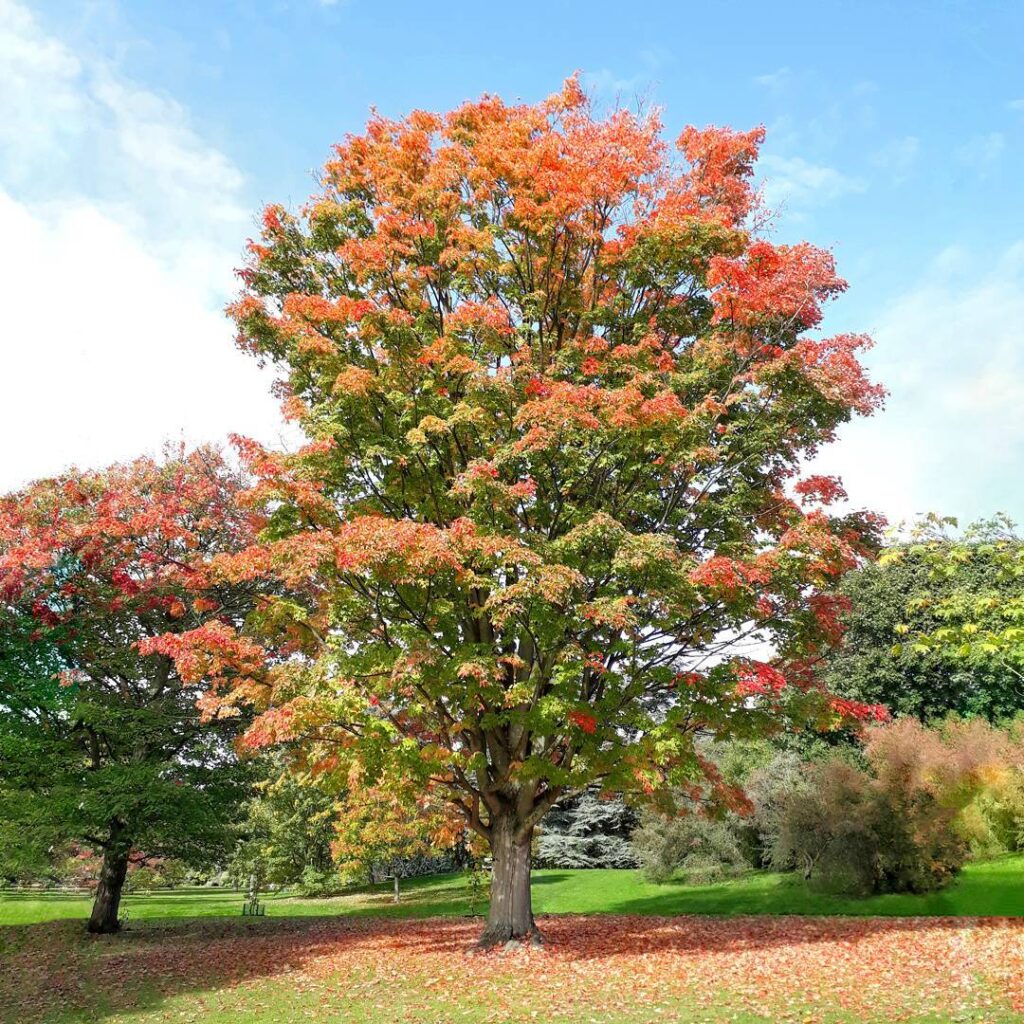
Sugar Maple (Acer saccharum) stands as one of Indiana’s most valuable native trees, serving as a cornerstone species in the state’s climax beech-maple forests. This medium to large deciduous tree is renowned for its spectacular fall display of orange, red, and yellow foliage and its five-lobed leaves with three prominent upper lobes and two smaller basal lobes.
Beyond its ornamental appeal, Sugar Maple holds tremendous economic significance as the primary source of maple syrup and sugar production. The wood is highly prized for furniture and flooring, while its dense canopy creates rich forest soil through abundant leaf litter. This shade-tolerant species thrives in Indiana’s upland forests, supporting diverse wildlife and playing an essential role in maintaining healthy mixed hardwood ecosystems throughout its range. Sugar Maple provides critical habitat by supporting at least 108 species of native moths.
- Hardiness: Native to all Indiana counties; cold hardy throughout eastern U.S. and southeastern Canada
- Light: Shade tolerant; thrives in partial to full shade conditions
- Water: Moderate moisture needs; avoids waterlogged or poorly-drained sites
- Soil: Rich, well-drained upland or alluvial soils; deep mesic conditions preferred; tolerates some sandy or rocky sites
- Fertilizer: Generally not needed; enriches soil naturally through leaf litter
- Pest/Disease Resistance: Generally hardy with good natural resistance
- Growth Rate: Moderate to slow; long-lived climax species
White Oak (Quercus Alba)
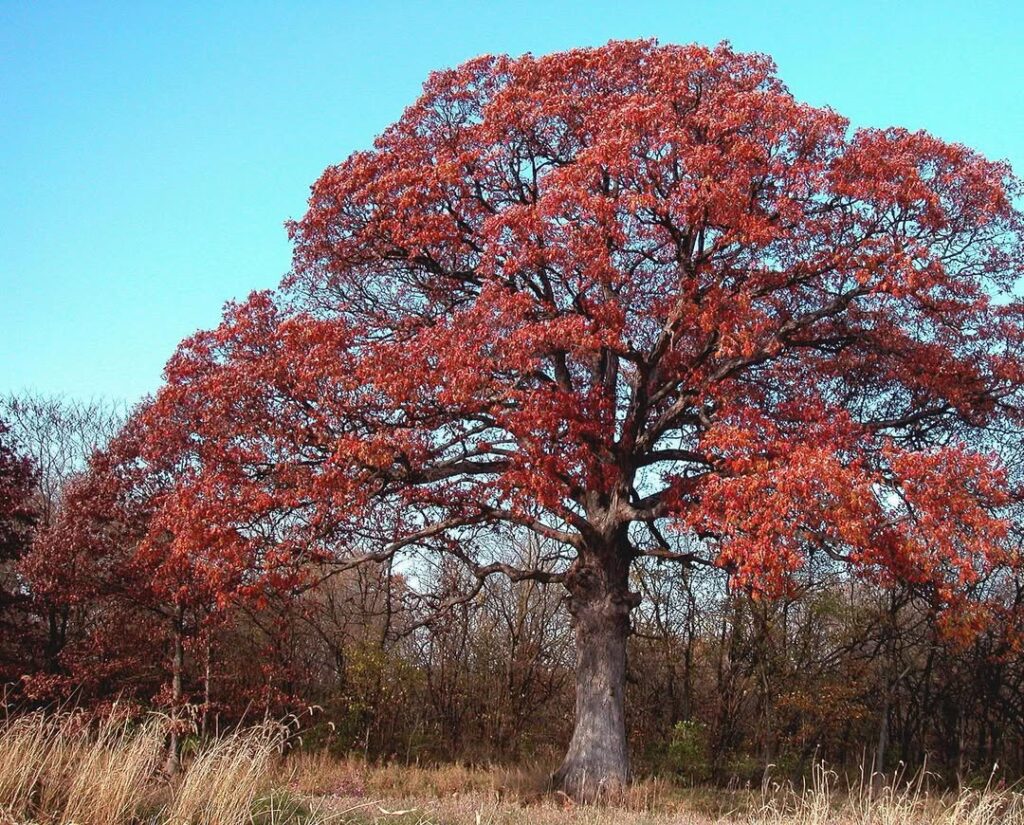
The White Oak (Quercus alba) stands as Indiana’s most magnificent native tree, earning the title “King of the Forest” for its impressive stature and ecological importance. Reaching 60-80 feet tall with a broad, rounded crown, this long-lived giant can survive for centuries while supporting an extraordinary 477 species of butterflies and moths—more than any other Ohio Valley tree.
Beyond its wildlife value, the White Oak produces dense, valuable lumber historically used in shipbuilding and remains the only approved wood for whiskey barrel production. Its acorns provide essential food for diverse wildlife, while its extensive root system offers excellent erosion control and carbon sequestration benefits, making it invaluable for conservation efforts. The distinctive rounded lobes on White Oak leaves make identification straightforward, distinguishing it from other oak species with pointed leaf tips.
- Hardiness: Zones 3-9, extremely hardy and long-lived
- Light: Full sun to partial shade
- Water: Moderate; tolerates both moist and dry conditions once established
- Soil: Adaptable to various soil types, from rich bottomlands to drier upland sites
- Fertilizer: None required; thrives in native soils
- Pest/Disease Resistance: Very good resistance to most pests and diseases
- Growth Rate: Slow but steady growth
American Elm (Ulmus Americana)

The American Elm is a majestic Indiana native tree that historically dominated urban landscapes throughout the northeastern United States. Known for its distinctive vase-shaped crown and ability to reach heights of 60-80 feet, this fast-growing deciduous tree was once the premier street tree in many cities due to its tolerance of urban conditions and beautiful form.
Despite its susceptibility to Dutch elm disease, which devastated populations in the 20th century, the American Elm remains an important ecological species in riparian areas and moist forests. Its drooping branches provide wildlife habitat, while its extensive root system helps stabilize streambanks and prevent erosion in floodplain environments. The species can be identified by its simple doubly-serrated oval leaves that feature distinctive large teeth with smaller teeth-like edges.
- Hardiness: USDA zones 2-9, native to Indiana and highly cold tolerant
- Light: Full sun to partial shade, adaptable to various light conditions
- Water: Moderate to high water needs, tolerates flooding and periodic wet conditions
- Soil: Adaptable to various soil types, prefers moist, well-drained sites; tolerates compacted urban soils
- Fertilizer: Low maintenance, typically does not require supplemental fertilization
- Pest/Disease Resistance: Highly susceptible to Dutch elm disease; tolerates urban pollution and road salt
- Growth Rate: Fast-growing, provides rapid canopy coverage
Indiana’s Hardy Native Shrubs
Indiana’s native shrubs offer year-round beauty and ecological benefits, thriving in diverse soil conditions while providing essential habitat for wildlife and adding seasonal interest to landscapes. These hardy selections reduce water usage compared to non-native alternatives, making them ideal for sustainable gardening practices.
Spicebush (Lindera Benzoin)
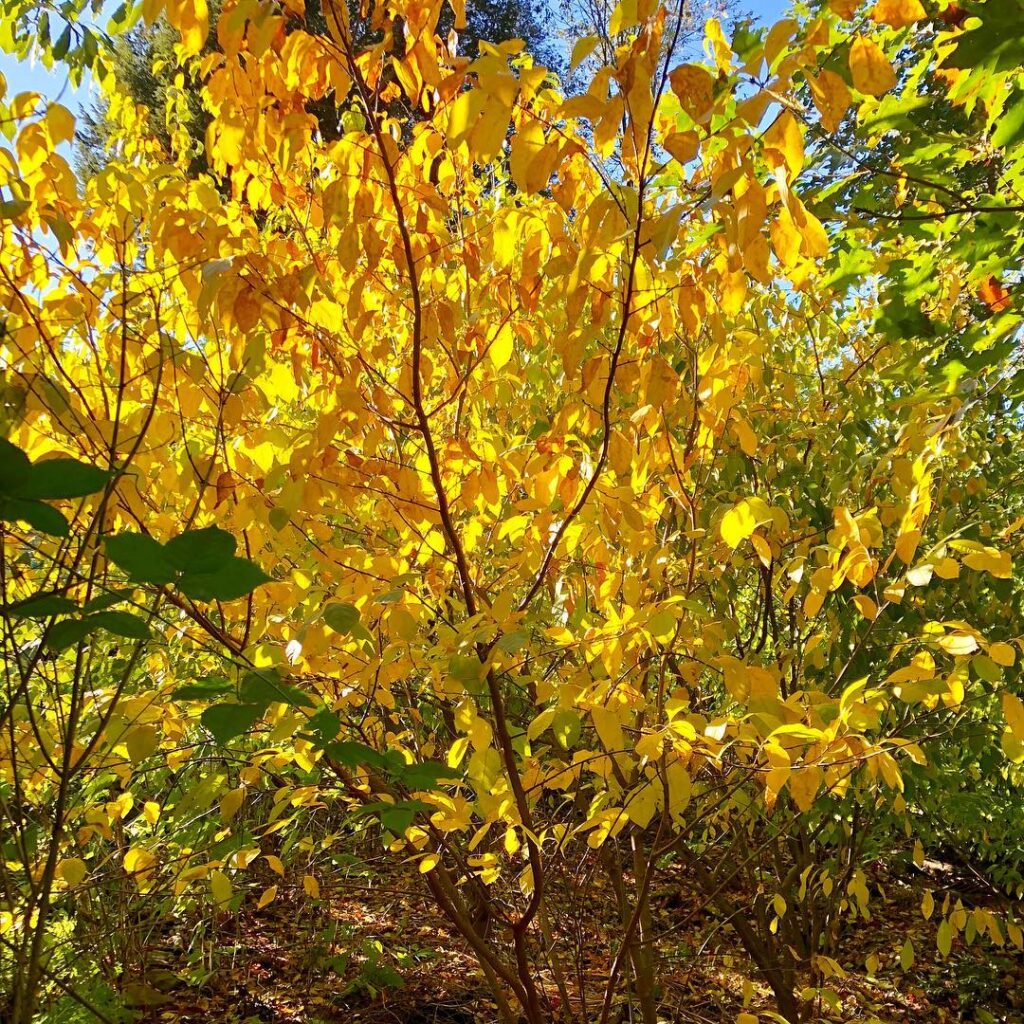
Spicebush (Lindera benzoin) is a versatile deciduous shrub native to Eastern North America that thrives throughout Indiana’s woodlands and stream borders. This aromatic plant typically grows 10-12 feet tall in sunny locations but remains more compact at 3-5 feet in shaded areas. Distinguished by its light-green, fragrant leaves that turn brilliant yellow-gold in fall, spicebush produces small yellow flowers in early spring before leafing out.
The shrub serves as an important wildlife plant, hosting Spicebush Swallowtail butterfly larvae and providing bright red berries that attract birds. Its glossy red fruit follows the clusters of pale yellow flowers, creating visual interest throughout the growing season. Its aromatic leaves, twigs, and fruits have been traditionally used for culinary and medicinal purposes, while the plant’s natural adaptability makes it excellent for woodland gardens, rain gardens, and restoration projects.
- Hardiness: USDA Zones 4-9
- Light: Partial shade to full sun; performs best in understory or dappled light
- Water: Moist to medium moisture; well-drained conditions preferred
- Soil: Sandy loam to clay; prefers rich, fertile, often limestone-influenced soils
- Fertilizer: Low maintenance; thrives in naturally fertile soils without supplemental feeding
- Pest/Disease Resistance: Resistant to most common pests and diseases in native range
- Growth Rate: Moderate; forms attractive thickets over time
Elderberry (Sambucus Canadensis)
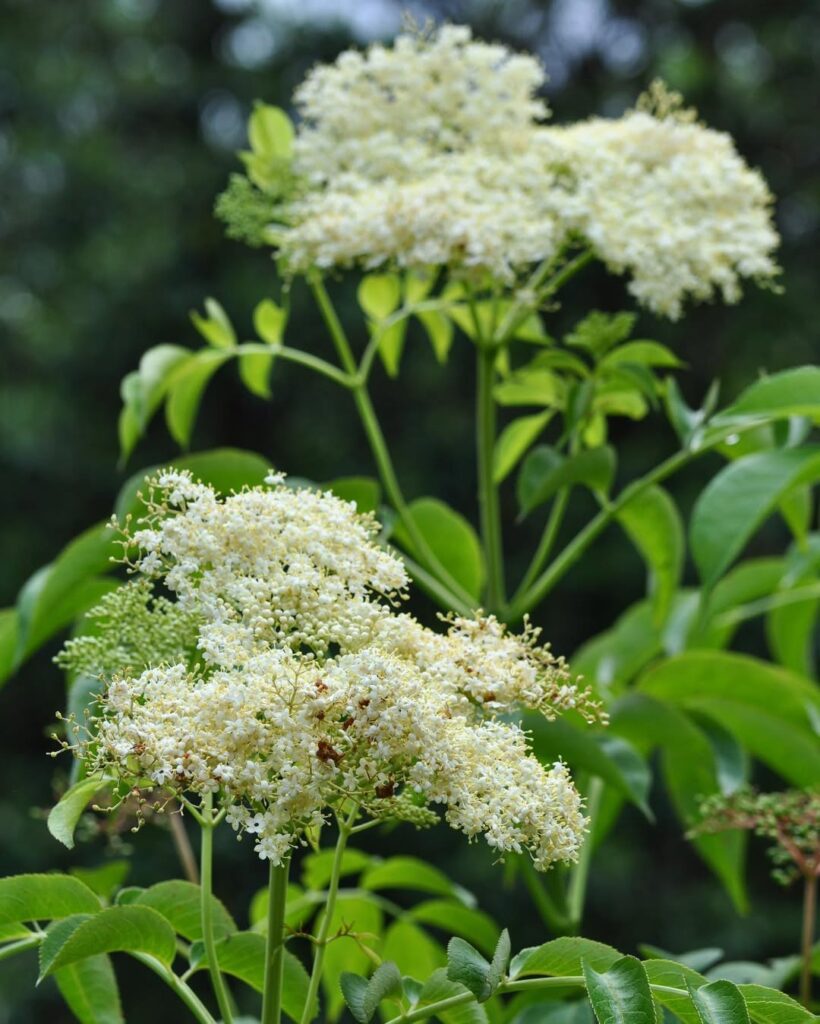
Elderberry (Sambucus canadensis) is a versatile native shrub that grows 4-15 feet tall and wide with a multi-stemmed, cane-like growth habit. This deciduous plant features pinnately compound leaves with 5-11 serrated leaflets and produces spectacular clusters of small white flowers in late spring, followed by dark purple-black berries in late summer.
The shrub thrives in diverse Indiana habitats from wetlands to old fields, making it excellent for naturalized plantings, privacy screens, or wildlife gardens. Its shallow, fibrous root system helps stabilize soils, while the flowers attract pollinators and berries provide essential food for songbirds and other wildlife. The flowers can be processed into medicinal syrups, jellies, wines, and cordials for various culinary and health applications.
- Hardiness: USDA zones covering Indiana’s climate; extremely hardy perennial
- Light: Full sun to partial shade; best berry production in full sun
- Water: Moderate to high; tolerates periodic flooding and moist conditions
- Soil: Well-drained soils preferred; pH 5.5-6.5; adaptable to various site conditions
- Fertilizer: Low maintenance; typically requires no supplemental fertilization
- Pest/Disease Resistance: Excellent; native status provides natural resistance to local issues
- Growth Rate: Fast; easily establishes and propagates in Indiana landscapes
Ninebark (Physocarpus Opulifolius)
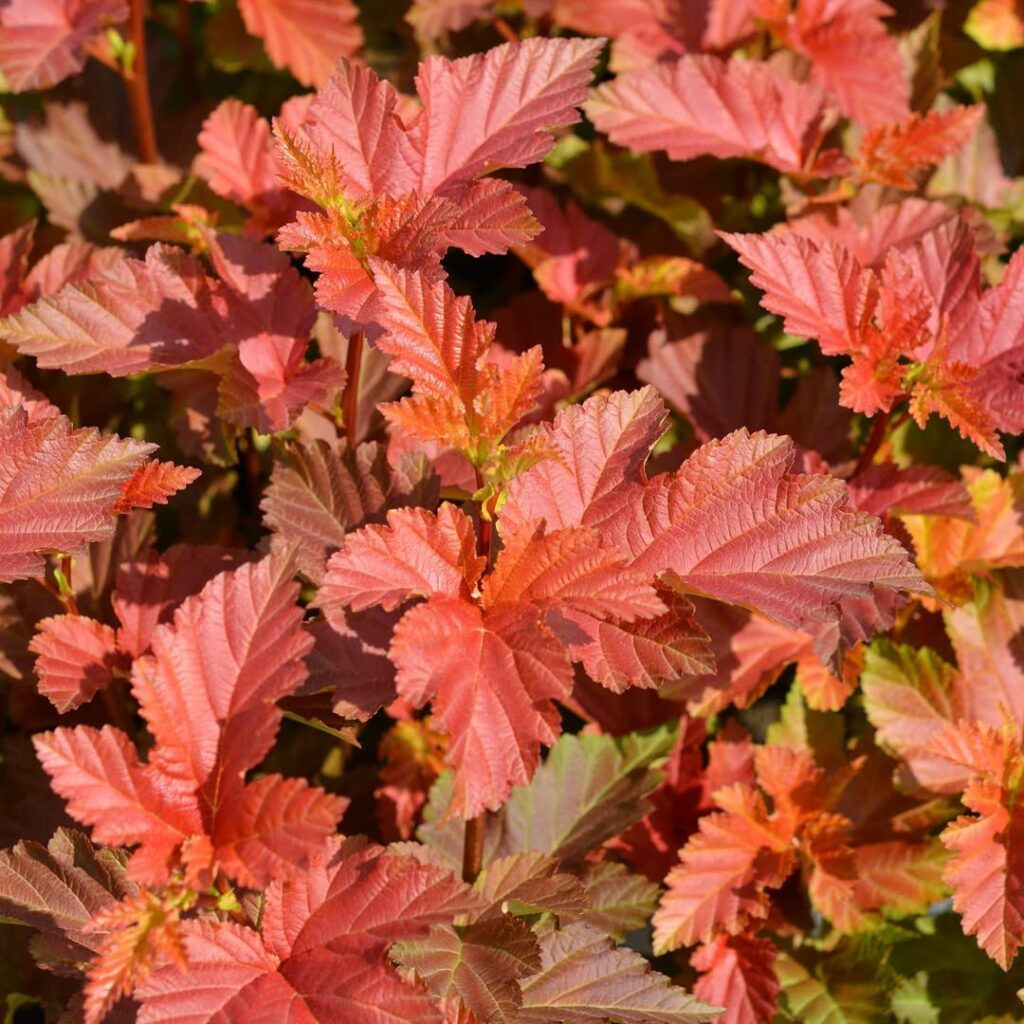
Ninebark (Physocarpus opulifolius) is a versatile native shrub prized for its year-round ornamental appeal. In late spring, it produces clusters of small white or pinkish flowers reminiscent of spirea, followed by persistent reddish-pink seed capsules. The plant’s distinctive exfoliating bark peels in strips to reveal colorful underlayers ranging from reddish to light brown, providing winter interest.
This multi-stemmed shrub grows 3-10 feet tall with an arching, rounded form. Cultivars offer diverse foliage colors from standard green to burgundy and chartreuse, with yellow fall color. Originally native to Indiana stream banks, ninebark adapts remarkably well to various garden conditions while supporting local wildlife, hosting moth larvae and attracting numerous pollinators including mining bees and butterflies. The shrub can be easily propagated through fall-sown seed or semi-hardwood cuttings with or without hormone treatment.
- Hardiness: USDA Zones 2-8
- Light: Full sun to partial shade
- Water: Drought tolerant once established; adapts to dry, medium, or moist conditions
- Soil: Tolerates clay, loam, or sand; adaptable to both acidic and alkaline pH
- Fertilizer: Low fertilizer requirements; thrives in average garden conditions
- Pest/Disease Resistance: Highly resistant to pests and diseases
- Growth Rate: Moderate
Serviceberry (Amelanchier Canadensis)
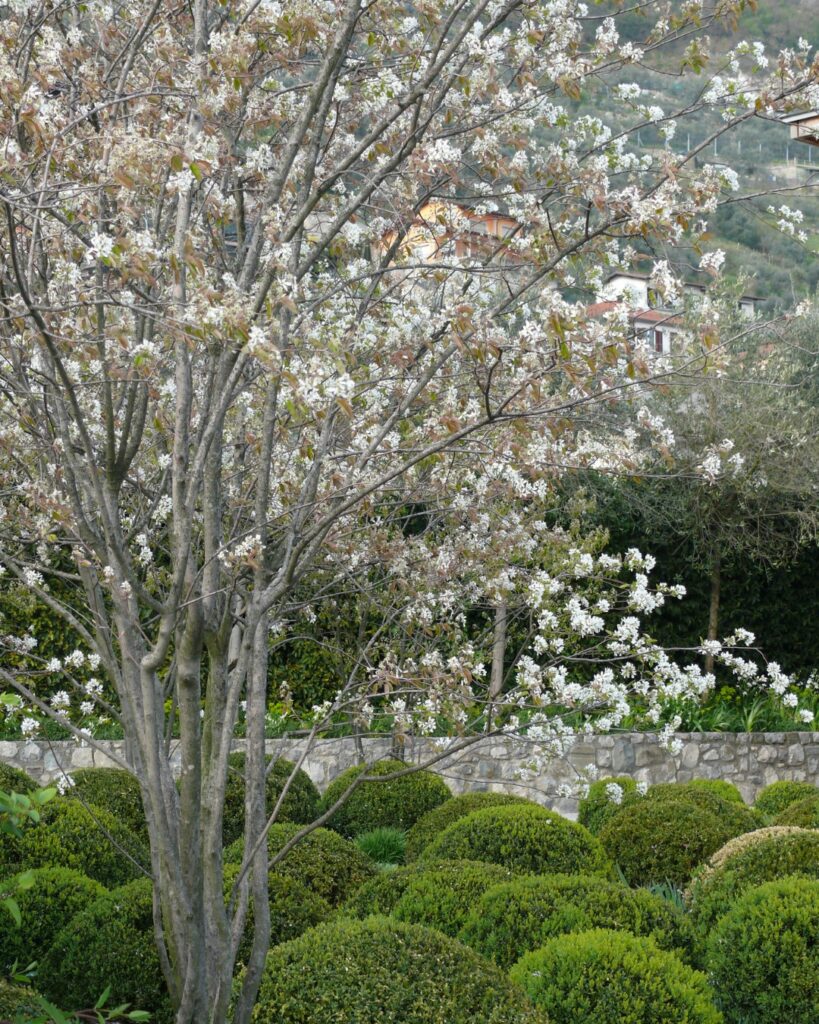
Serviceberry (Amelanchier canadensis) is a versatile native shrub that serves as an excellent choice for Indiana landscapes. Growing 15-25 feet tall with a multi-trunked form, this deciduous plant offers remarkable three-season interest. In early spring, clusters of fragrant white flowers appear before the leaves emerge, followed by sweet, edible purplish-red to black berries in summer that attract numerous bird species including goldfinches, cardinals, and robins.
The plant’s coarsely toothed, leathery leaves provide vibrant red and orange fall color, while its smooth gray bark adds winter interest. Native to eastern North America’s swamps, bogs, and streambanks, serviceberry thrives in woodland settings and naturalized areas. Its early blooms provide essential nectar for pollinators, and the delicious berries can be used for human consumption in jams and pies, making it both ecologically and practically valuable. This species forms dense thickets that provide valuable habitat for wildlife while enhancing biodiversity in garden settings.
- Hardiness: USDA zones 4-9
- Light: Part shade preferred; tolerates full sun with adequate moisture
- Water: Adaptable to both wet and dry conditions; drought tolerant once established
- Soil: Various soil types including sandy loam, clay, and moderately saline soils
- Fertilizer: Low maintenance; minimal fertilizer requirements
- Pest/Disease Resistance: Generally resistant to pests and diseases
- Growth Rate: Moderate; slow to flower initially but provides long-term landscape value
Gray Dogwood (Cornus Racemosa)

Gray Dogwood is a versatile native shrub that forms attractive thickets through its suckering habit. This multi-stemmed member of the dogwood family reaches 10-15 feet in height and spread, featuring distinctive gray bark on mature branches and red-brown young twigs. The shrub provides year-round interest with creamy white flower clusters in May, white berries against red stems in late summer, and burgundy fall foliage.
Exceptionally adaptable to challenging growing conditions, Gray Dogwood thrives in locations where other plants struggle. Its tolerance for various light levels, soil types, and moisture conditions makes it ideal for naturalizing difficult sites. The berries provide valuable wildlife food, while the thicket-forming habit offers excellent cover and nesting habitat for birds. This native shrub also attracts bees and butterflies with its creamy-white flowers for vital pollen and nectar resources.
- Hardiness: Native to Indiana and throughout Central and Eastern North America
- Light: Full sun to full shade (as little as 4 hours daily)
- Water: Highly adaptable; tolerates drought, flooding, and consistently wet sites
- Soil: Adaptable to dry, wet, alkaline, and clay soils; excellent for pond and stream banks
- Fertilizer: No special fertilizer requirements as a native species
- Pest/Disease Resistance: Generally resistant due to native adaptation
- Growth Rate: Slow, allowing controlled landscape expansion
Selecting the Right Native Plants for Your Garden
When you’re choosing native plants for your Indiana garden, you’ll want to match each species to the right spot based on sunlight, soil type, and available space. Smart native plant selection starts with understanding your site conditions. Pawpaws tolerate full sun to partial shade and prefer loamy, acidic soil, reaching 15-30 feet at maturity. Tulip trees need full sun and grow 70-90 feet tall, so they’re perfect for larger properties. Check USDA hardiness zones too—pawpaws thrive in zones 5-9, while tulip trees handle zones 4-9. Once established, native plants require little maintenance and are naturally adapted to southern Indiana conditions. Good garden design considers these factors for long-term success.
Frequently Asked Questions
When Is the Best Time to Plant Native Species in Indiana?
Strike while the iron’s hot—you’ll find three ideal planting seasons for Indiana natives. Weather considerations matter: spring (April-May) for seeds, dormant winter seeding (December-February), and early fall (September-October) for transplants.
How Much Do Native Plants Typically Cost Compared to Non-Native Varieties?
Native plants typically cost more upfront than non-natives—you’ll pay $18 for native perennials versus $2.50 for petunias. However, cost comparison shows pricing factors like plug sizes and bulk orders reduce expenses considerably.
Where Can I Purchase Native Indiana Plants and Seeds Locally?
You can find native Indiana plants at local nurseries like Goldfinch Native Plant Nursery and Native Plants Unlimited. Check seed swaps through Indiana Native Plant Society, community events, and seasonal sales at venues like Geist Nursery.
Do Native Plants Require Special Fertilizers or Soil Amendments?
Over-fertilizing kills 40% of native plantings! You don’t need special fertilizers or soil amendments for native plant care. These species naturally improve soil health once established, thriving in Indiana’s existing conditions without expensive chemical inputs.
How Long Do Native Plants Take to Establish After Planting?
You’ll see native plants take 3-5 years to fully establish from seed. The establishment timeline depends on growth factors like species type, planting method, site preparation, and seasonal timing affecting root development and maturity.
